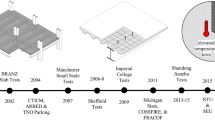Abstract
Fire safety in buildings (FIS) is characterized by the multidimensionality of the contents associated with it, ranging from the behaviour of materials at high temperatures to the evacuation of people in case of fire. FIS is ensured by imposing a set of requirements translated into a legal body consisting of regulations and standardization, whose goal is to reduce the fire risk for occupants and firefighters involved in fighting a fire. The knowledge required to build up this body of law essentially derives from the theoretical evolution that has been consolidated over time. However, there are areas in which this knowledge is derived from tests carried out following standardization, as the case of construction products. In the case of European standardization, it is essential, firstly, to assess, two decades after its publication whether there is a need for adjustments to the conditions under which they are carried out. Secondly, it is necessary to identify possible gaps where the development of new knowledge derives from the performance of tests. This text addresses these two perspectives and the possible consideration of what we call virtual tests.
Access this chapter
Tax calculation will be finalised at checkout
Purchases are for personal use only
Similar content being viewed by others
References
Commission Decision of 8 February 2000 implementing Council Directive 89/106/EEC on the classification of construction products with regard to reaction to fire performance (2000/147/EC). Official Journal of the European Communities (JOCE), L 50, 2000-02-23, p 14–18
COMITÉ EUROPÉEN DE NORMALISATION (CEN) (2002) Fire classification of construction products and building elements. Part 1: classification using test data from reaction to fire test. Brussels, CEN. EN 13501-1
CEN (2002) Reaction to fire test for building products. Non-combustibility. Brussels, CEN. EN ISO 1182
CEN (2002) Reaction fire tests for building products. Determination of the heat of combustion). Brussels, CEN. EN ISO 1716
CEN (2002) Reaction to fire tests for building products. Building products excluding floorings exposed to the thermal attack by a single burning item. Brussels, CEN. EN 13823
CEN (2002) Reaction to fire tests–ignitability of building products subjected to direct im**ement of flame. Part 2: single-flame source test. Brussels, CEN. EN ISO 11925-2
CEN (2002) Reaction to FIRE tests for floorings. Part 1: determination of the burning behaviour using a radiant heat source. Brussels, CEN. EN ISO 9239-1
International Organization standardization (ISO) (1993) Fire tests-full-scale room test for surface products. Genéve, ISO. ISO 9705:1993
European Commission (EC), The European classification system for the reaction to fire performance of construction products. Brussels: the Commission, December 1999. Guidance Paper G
ISO 19702:2015, Guidance for sampling and analysis of toxic gases and vapours in fire effluents using fourier transform infrared (FTIR) spectroscopy
American Society for Testing and Materials (ASTM) (2000) Standard test methods for fire tests of building construction and materials. E 119, ASTM, pp 1–21
ISO 834-1 (1999) Fire-resistance tests-elements of building construction. Part 1: general requirements. Geneva, ISO
EN1991-1-2 (2002) Eurocode 1: actions on structures. Part 1–2: general rules–actions on structures exposed to fire. Brussels, CEN
EN1993-1-2 (2005) Eurocode 3: design of steel structures. Part 1–2: general rules–structural fire design. Brussels, CEN
EN1994-1-2 (2005) Eurocode 4: design of composite steel and concrete structures. Part 1–2: general rules–structural fire design. Brussels, CEN
EN 1995-1-2 (2004) Eurocode 5: design of timber structures. Part 1–2 general–structural fire design. European standard. CEN, Brussels
CIB-Council for Research and Innovation in Building and Construction. http://www.cibworld.nl/
NIST-National Institute of Standards and Technology. http://www.nist.gov/
Yang JC, Bundy M, Gross J, Hamins A, Sadek F, Raghunathan A (2015) International R&D roadmap for fire resistance of structures-summary of NIST/CIB Workshop. Fire Research Division, Engineering Laboratory, NIST Special Publication 1188
BS 8458:2015, Fixed fire protection systems-residential and domestic watermist systems-code of practice for design and installation
AS 1851-2012, Australian standard-routine service of fire protection systems and equipment
Baur C, Wee D (2015) Manufacturing’s next act. In: Mckinsey.Com (issue June). https://www.mckinsey.com/business-functions/operations/our-insights/manufacturings-next-act
Rowsell-Jones A, Lowendahl JM, Howard C, Nielsen T (2016) The 2017 CIO agenda: seize the digital ecosystem opportunity. Technical Report, Gartner Inc
Sawhney A, Riley M, Irizarry J (2020) Construction 4.0 introduction and overview. In: Construction 4.0 an innovation platform for the built environment, vol 53, issue 9
Silva JFM, Almeida JE, Pereira A, Rossetti RJF, Coelho AL (2013) Preliminary experiments with EVA-serious games virtual fire drill simulator. In: 27th EUROPEAN conference on modelling and simulation (ECMS 2013). Ålesund, Norway
Author information
Authors and Affiliations
Corresponding author
Editor information
Editors and Affiliations
Rights and permissions
Copyright information
© 2023 The Author(s), under exclusive license to Springer Nature Switzerland AG
About this chapter
Cite this chapter
Gonçalves, M.C., Coelho, A.L. (2023). State-of-the-Art and Future Insights into the Material’s Fire Behaviour Tests. In: Chastre, C., Neves, J., Ribeiro, D., Neves, M.G., Faria, P. (eds) Advances on Testing and Experimentation in Civil Engineering. Springer Tracts in Civil Engineering . Springer, Cham. https://doi.org/10.1007/978-3-031-23888-8_16
Download citation
DOI: https://doi.org/10.1007/978-3-031-23888-8_16
Published:
Publisher Name: Springer, Cham
Print ISBN: 978-3-031-23887-1
Online ISBN: 978-3-031-23888-8
eBook Packages: EngineeringEngineering (R0)




